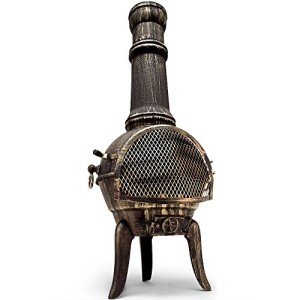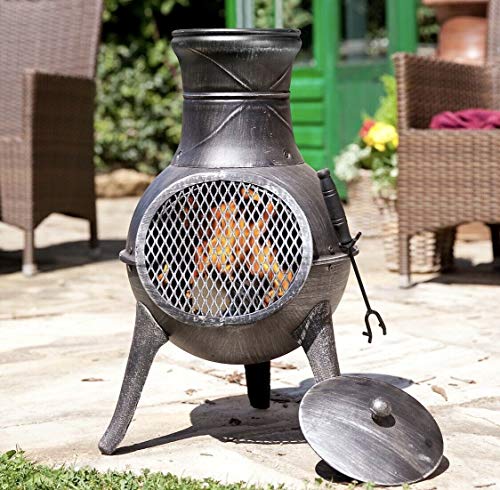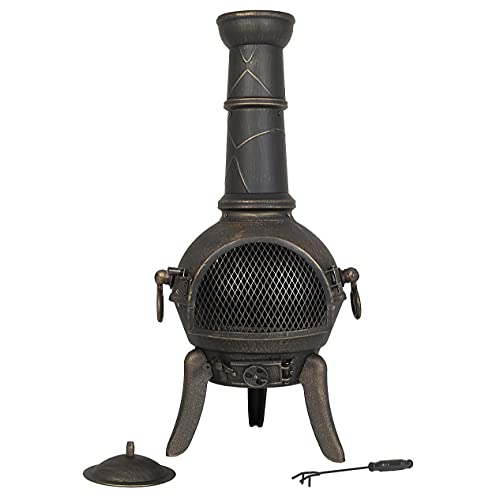In an age where outdoor living is becoming increasingly popular, the quest for unique and functional outdoor heating solutions continues. One such option that combines aesthetic appeal with practicality is the rustic cast iron steel chiminea fire pit. These striking outdoor fixtures not only provide warmth during cozy evenings but also serve as a central gathering point for friends and family. This guide explores the features, benefits, maintenance, and safety considerations of rustic cast iron steel chimineas, along with frequently asked questions.
What is a Chiminea?
Originally designed in Mexico, a chiminea is a freestanding fireplace with a rounded body and an extended chimney. It is designed to contain fire and direct smoke upward, reducing the amount of smoke that disrupts the atmosphere for users.
Features of Rustic Cast Iron Steel Chimineas:
- Materials: Cast iron and steel are durable metals that can withstand high temperatures, making them ideal for outdoor fire pits.
- Design: The rustic design often includes intricate patterns or motifs, blending seamlessly into natural landscapes.
- Chimney: The extended chimney allows for proper ventilation and minimizes smoke.
Benefits of Using a Rustic Cast Iron Steel Chiminea Fire Pit
Rustic cast iron steel chimineas offer several advantages that enhance the outdoor experience:
1. Aesthetics:
- Adds visual interest to outdoor spaces.
- Can act as a decorative element while providing functionality.
2. Heating:
- Provides warmth during chilly evenings, extending the outdoor living season.
- Radiates heat in a 360-degree fashion.
3. Portability:
- Many models are designed to be lightweight and easy to move.
- Possibility to relocate it according to the season or occasion.
4. Versatility:
- Suitable for cooking, allowing for grilling and roasting over an open flame.
- Compatible with different types of fuel, including wood, charcoal, or even gas in some models.
5. Durability:
- Cast iron and steel construction means that chimineas can withstand various weather conditions.
- Rust-resistant coatings increase longevity.
Maintenance Tips for Rustica Cast Iron Steel Chimineas
To maintain a rustic cast iron steel chiminea and ensure its longevity, follow these essential maintenance tips:
1. Regular Cleaning:
- Remove ash and debris after each use.
- Clean the exterior with a mixture of vinegar and water to counteract rust.
2. Seasonal Care:
- Cover the chiminea during the off-season to protect it from harsh weather elements.
- Inspect it for any signs of damage or wear before use.
3. Fuel Management:
- Use dry wood to prevent excessive smoke.
- Avoid burning treated or painted wood, which can release harmful chemicals.
4. Rust Prevention:
- Apply a high-temperature paint or sealant specifically designed for metal to prevent rust.
- Store it in a moisture-free area when not in use.
Safety Considerations
While a rustic cast iron steel chiminea can elevate outdoor living, safety should always be a priority:
- Placement: Position the chiminea away from flammable materials, such as patio furniture, trees, or structures.
- Supervision: Always monitor the fire, particularly with children and pets nearby.
- Extinguishing: Keep a bucket of water or sand nearby for emergency extinguishing.
- Ventilation: Ensure adequate ventilation, particularly if using a larger chiminea indoors (although mostly outdoor use is recommended).
Comparison Table: Rustic Cast Iron Steel Chiminea vs. Other Outdoor Heating Choices
| Feature | Rustic Cast Iron Steel Chiminea | Fire Pit Tables | Portable Fire Pits |
|---|---|---|---|
| Style | Rustic, often decorative | Modern, versatile | Compact, easy to transport |
| Heat Distribution | 360-degree heating | Limited to table area | Varies by design |
| Fuel Type | Wood, charcoal, gas | Usually gas or propane | Wood or propane |
| Durability | High (with proper upkeep) | Varies by material | Generally moderate |
| Maintenance | Moderate | Low to moderate | Low |
| Cooking Capability | Yes | Limited | Often yes (dependent on design) |
Frequently Asked Questions (FAQs)
Q1: Can a chiminea be used in winter?
Yes, a chiminea can be used in winter, providing there is no snow or ice accumulation. However, adequate preparation and maintenance are required to ensure functionality during colder months.
Q2: What type of fuel should I use?
Most rustic cast iron steel chimineas are designed for burning wood or charcoal. Ensure that you are using dry, untreated wood to minimize smoke and toxins.
Q3: Is it safe to leave a chiminea unattended?
No, it is not safe to leave a chiminea unattended when lit. Always keep an eye on the fire, especially if children or pets are nearby.
Q4: Can I use my chiminea indoors?
It is not advisable to use a chiminea indoors due to the risk of smoke buildup and carbon monoxide. They are primarily designed for outdoor use.
Q5: What should I do before storing my chiminea for the season?
Before storing, clean out any ash and debris, make necessary repairs, and cover with a tarp or chiminea cover to protect against the elements.
A rustic cast iron steel chiminea fire pit adds warmth, beauty, and character to outdoor spaces. Its versatility in heating and cooking, along with its aesthetic appeal, makes it a valuable addition. With the proper maintenance and safety precautions, it can enhance outdoor living experiences for years to come. For anyone looking to create a cozy outdoor ambiance, a rustic chiminea could very well be the centerpiece that transforms their backyard into a gathering spot.






